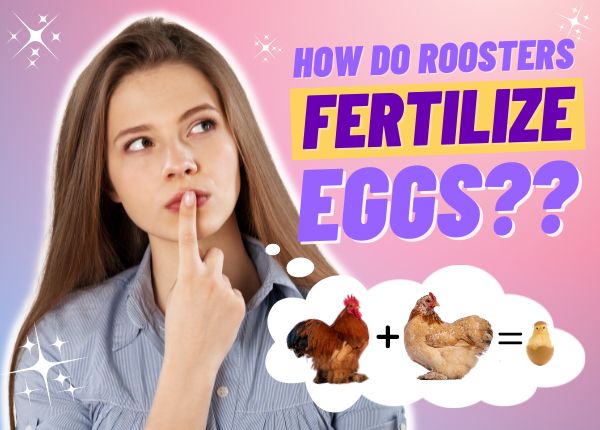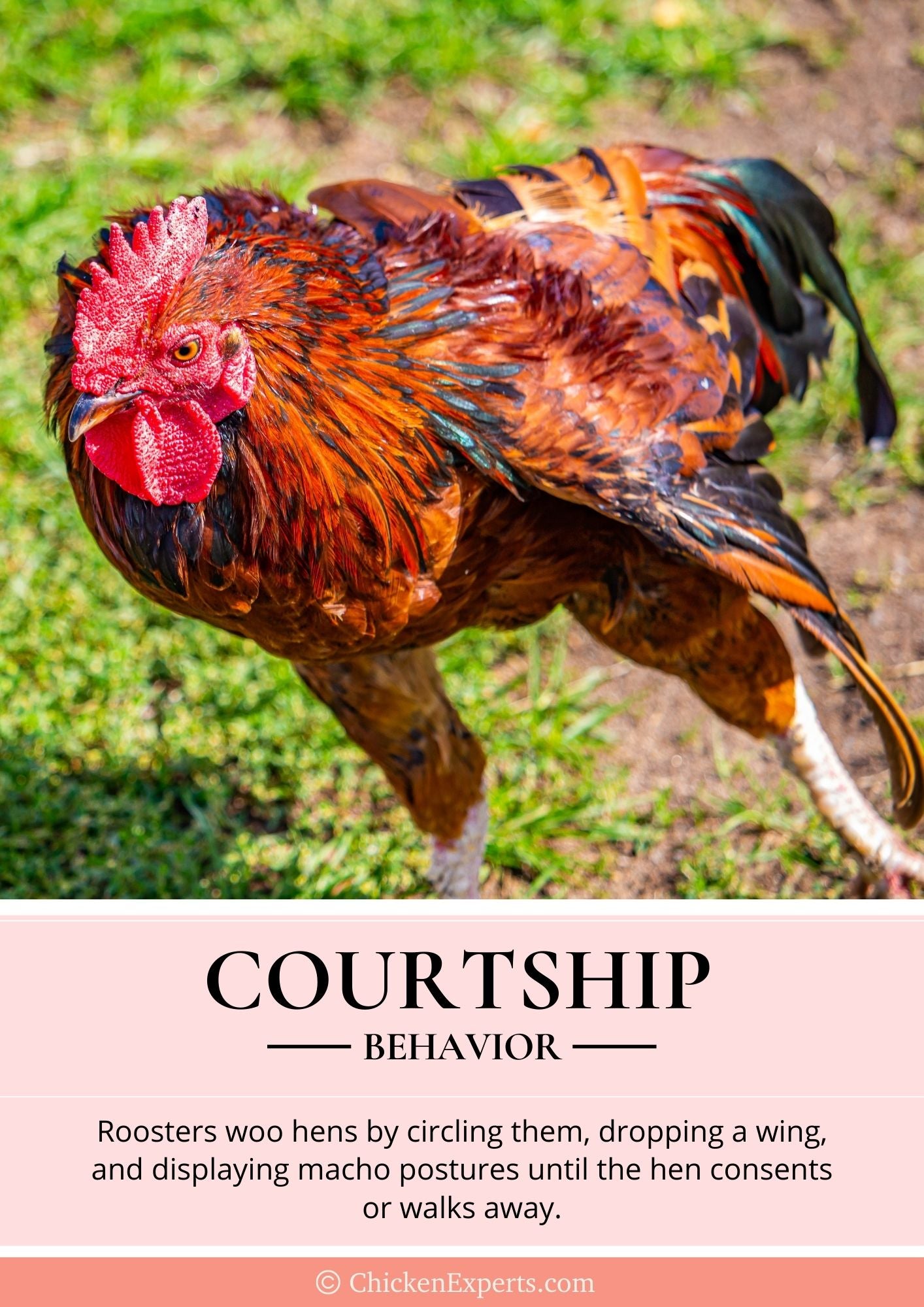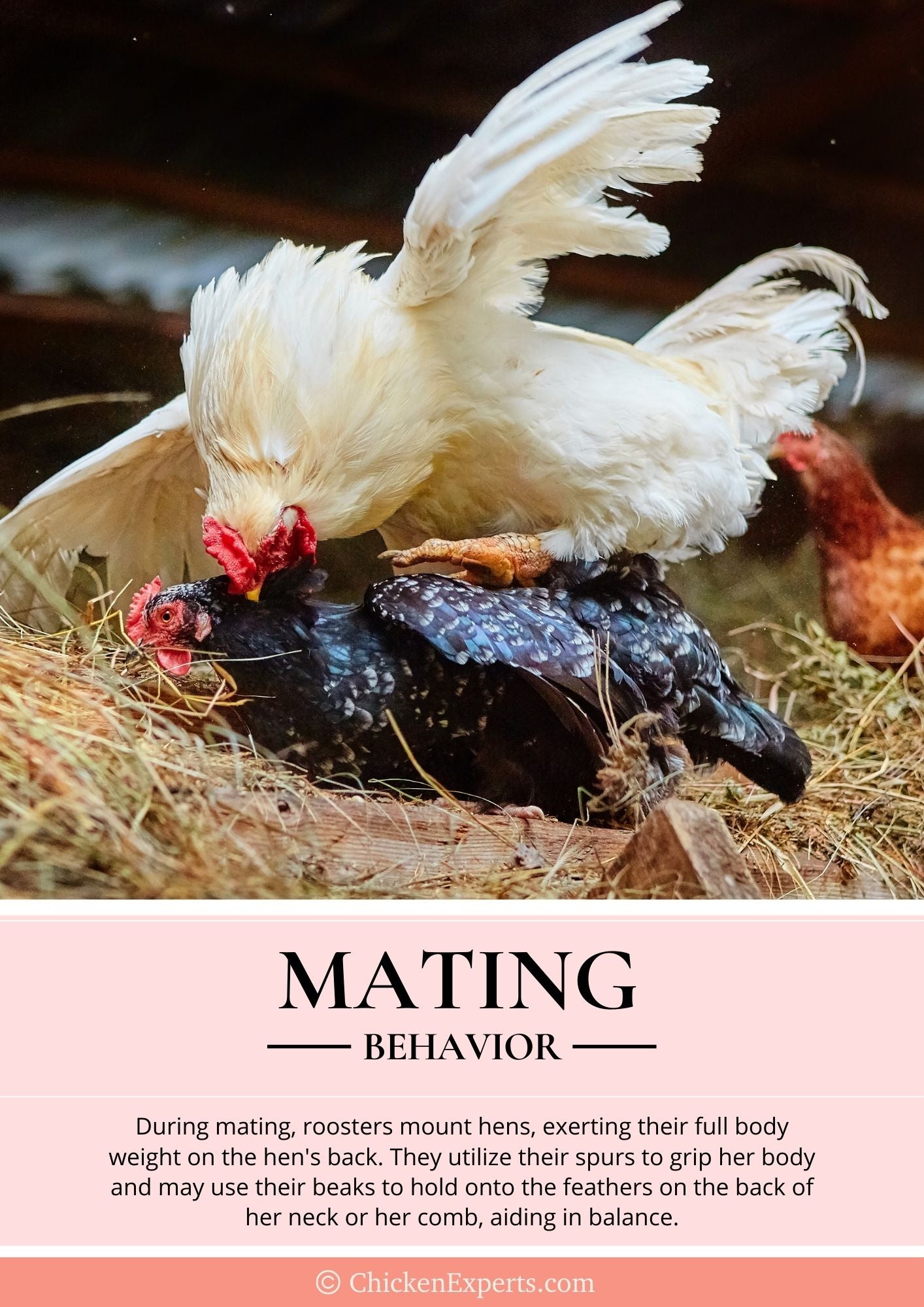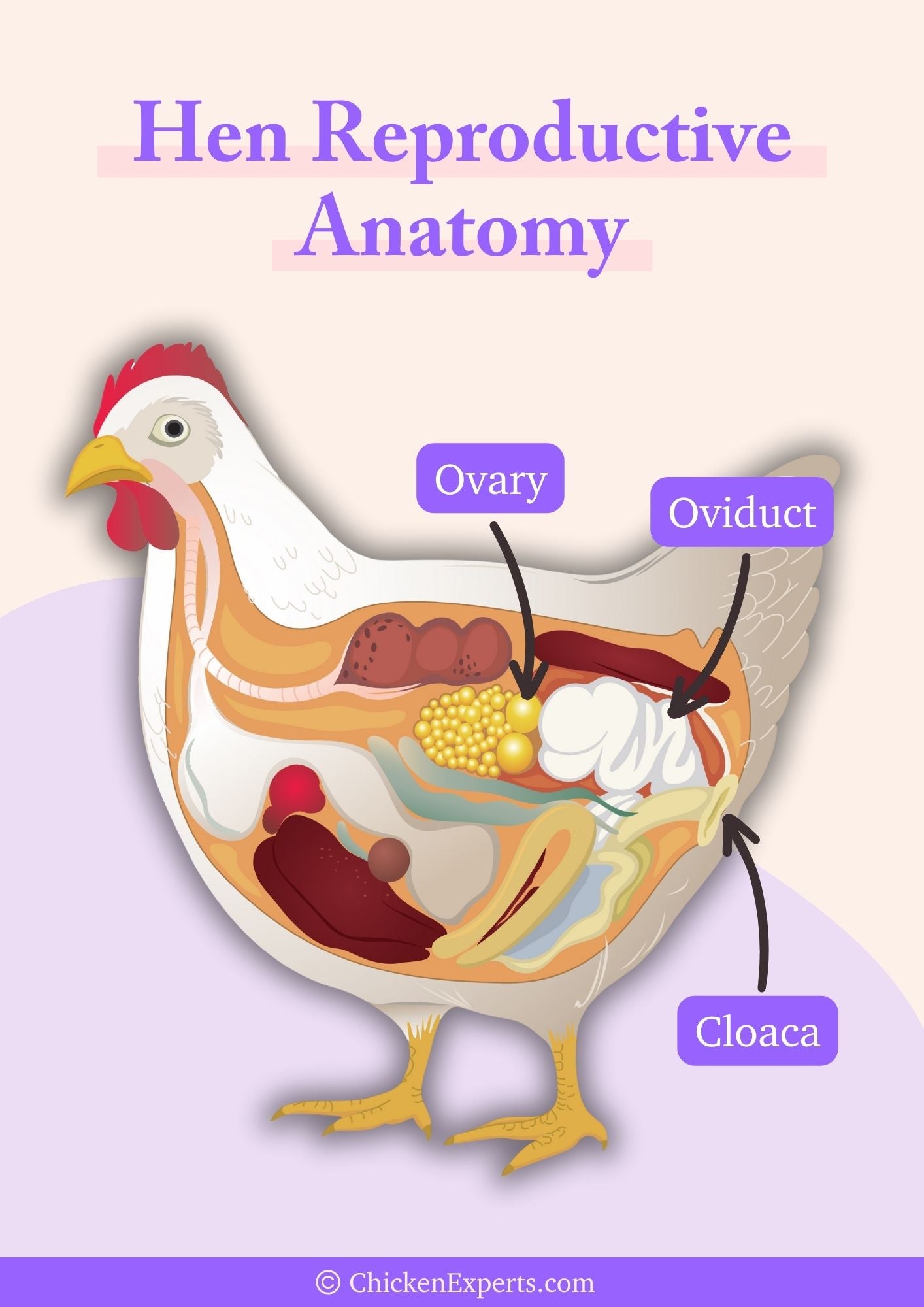
I hope you’re ready for some eggs-rated reading because I won’t be skimming over any awkward details here!
Chicken reproduction can make us question our understanding of the birds and the bees because, well, chickens do things a little differently…
Chicken courtship is unique, bizarre, and utterly fascinating. Hens will lay eggs with or without the assistance of a rooster, so how do we know whether Mr. Cocky over there has been involved?
If you keep chickens at home, then you’ll need to understand the workings of the poultry dating scene regardless of whether you’re looking to breed your chickens or not. It’ll help you decide if roosters are right for your backyard, recognize courtship over displays of dominance, and know when to intervene.
If baby chicks are on your wish list, then please trust me when I say that you cannot wing raising chicks. Even with the broodiest Momma hen and the most protective Papa roo, baby chicks are very fragile, and things often go wrong. You can dodge disaster though with the right knowledge and skill set, and watching peeps hatch into your home is honestly one of the most amazing sights you’ll ever see!
Chickenpedia is like an antenatal class for future chick parents and the easiest way to ditch your doubts and just enjoy the journey.
If you don’t keep chickens but you have questions about chicken eggs, then you’ll learn how to spot a fertilized egg 🥚 and understand what you’re eating, right here.
Let’s get started! First I’ll answer your chicken fertilization questions, starting with 5 fascinating facts about chicken reproduction. Next up is the nitty gritty! The science bit - if you like. I’ll cover all the need-to-know facts about chicken anatomy, the chicken mating process, and how roosters fertilize eggs.
5 FASCINATING CHICKEN FERTILISATION FACTS
Did you know…
- A rooster can control the amount of semen he releases each time he mates meaning that he can set some aside ready for the next clucky lady he has in mind.
- Hens can eject sperm after mating to avoid fertilization if they aren’t best pleased with what the rooster had to offer. (It’s not just the boys who call the shots.)
- Roosters don’t have a penis. They start to develop them as embryos and then a certain protein they produce hinders any further development.
- Hens only have one functional ovary – and it’s always the one on the left!
- Chickens can change gender. Seriously!

There’s more…so keep reading!
TOP 5 CHICKEN FERTILIZATION FAQS
Your Questions Answered…
1. Are Yolks Baby Chicks That Didn’t Live?
Yolks are not baby chickens. All eggs contain yolk sacks which become the nutrient source for baby chicks if the egg is fertilized. That’s why eating a yummy yellow yolk is so nutritious.
2. Do Hens Need Roosters to Lay Eggs?
Hens don’t need roosters to lay eggs. Hens lay just as many edible eggs with or without a rooster present to fertilize them.
3. Are Fertilized Eggs Safe to Eat?
It’s perfectly safe to eat a fertilized egg, though we’d all rather avoid it. The teeny tiny cells would be invisible and you can’t taste the difference, but technically speaking once an egg is fertilized it’s no longer a vegetarian food source.
4. Are Store-Bought Eggs Fertilized?
The eggs you buy from the supermarket won’t be fertile as production hens aren’t kept with roosters. Even if a very determined young cockerel had hopped the fence and embarked on a cheeky romance, store-bought eggs are always chilled in the US, so an embryo would have no chance of developing.
5. How Quickly Do Hens Conceive?
After a rooster has mated with a hen it could take as little as 27 hours for a fertile egg to be laid, or as long as a month since hens can store sperm until they want to use it. Clever clucks!
CHICKEN COURTSHIP & MATING BEHAVIOUR
This is the flirty, fluffy stuff…
Chicken Courtship
Roo-mance is not the same as romance. Sure, the guys do a little dance for their girls, but that’s often the end of their gentlemanly ways, I’m afraid.
If a rooster 🐓 wants to mate with a hen, then he’ll usually perform the wing dance for her. I say usually because as time goes by he’ll stop bothering. You know the story.

A rooster’s advance involves the roo approaching the hen from the side, dropping one wing down to the ground, and doing a bit of a scratchy, shuffle-like jig in circles around her. He’ll flex his muscles a bit and spread his wings to make him look macho and he’ll keep going until she either consents or wanders off and rejects him.
If the hen does consent to Mr. Chicken’s suggestion, then she’ll squat close to the ground, lower her head, slightly spread her wings, and raise her tail high and to one side and the rooster will take up his position on her back to mate.
If the hen doesn’t consent – I’m sorry to spoil the love story here – but one of two things will happen: a bashful rooster will sulk (which is understandable), or a rude roo will overpower the hen and attempt to mate anyway.
Natural Selection in Chickens
Why would a hen reject a roo’s advances? Natural selection works just the same for chickens as any other animal. Hens are looking for a strong genetic match, not just a fling.
They’re not searching for someone who shares their passion for polo or has a stable career, but he does need to be fit and healthy, and handsome doesn’t hurt.
What’s handsome in a hen’s eyes? Successful roosters are strong, shiny, well-groomed, brave, and sport a stunning red comb and wattle. Oh my!
I might have been a tad unfair saying that Roosters don’t do romance. The mating process itself can be brutal, as you’re about to read, but some rooster owners praise their boys for being protective, attentive, and gentle with their hens. Some breeds of rooster are friendlier than others, and some will even step in with childcare caring for their chicks whilst Momma takes a break.
Hens are not shallow. It’s not all about looks. Hens are looking for a provider, too. A rooster who invests his time and effort in his hens will have a much better chance at mating cooperatively. Courtship starts well before the final advances of the wing dance. Roosters must prove themselves to new hens and it will often take a week to woo a female or two.
Roosters wow the ladies by displaying their protective nature and warding off threats to the flock like other pets, predators, or the mailman.
“…hens were found to be more likely to eject sperm after successive matings, favouring their first partners to the detriment of later ones. They also ejected a larger proportion of the sperm of socially subordinate males, giving more dominant males an advantage.(University of Oxford)
What is Tid Bitting?
Roosters are known to titbit to impress hens. They’ll forage for tasty treats like grubs and alert the hen that she’s welcome to dine. It’s not entirely selfless, he has an ulterior motive, and this is it…
THE MATING PROCESS IN CHICKENS
The eggs-rated bit…
How Do Chickens Mate?
It’s important to understand how chickens mate otherwise you will panic when you witness it for the first time.
You’ll also need to know if and when to intervene. There are cases when you should help your hens out by removing the rooster, protecting hens with saddles, or adjusting the flock dynamics.
Roosters mount the hen - which is sometimes called treading - placing their entire body weight on her back and using their spurs to grip her body. They’ll also use their beaks to grab the feathers on the back of the hen's neck, or her comb, to help them balance.

As I’m sure you can imagine it’s a difficult position to hold, especially when a matter of intricacy needs to follow. As a result, there can be a lot of flapping about and squawking and it can look very uncomfortable, to say the least.
The Cloacal Kiss
Once in position, the deed itself only takes a few seconds. The rooster lowers his cloaca, and the female inverts her cloaca until they touch. This is called the Cloacal kiss. There’s no penetration involved since roosters don’t have penises.
During the cloacal kiss the hen opens her cloaca so that the rooster’s sperm can be passed effectively from his papilla into her oviduct.
Does Fertilization Hurt Hens?
Mating in chickens can be brutal. I wish I could say that it doesn’t hurt hens, but anyone who has kept hens and witnessed mating will know there’s nothing gentle about it.
Roosters can mate 10 to 30 times a day, which allows them to cover 10-15 hens. If a rooster doesn’t have access to enough hens, then he’ll place all his egg-specations on just one or two, which can become painful and distressing for them.
Roosters often have favorite hens which means even in larger flocks some females get more attention – wanted or unwanted – than others do.
You’ll need to keep a close eye on your hens to make sure they aren’t being injured durng mating. The most common issue is the loss of feathers around the neck, or lacerations to the body from the rooster’s spurs. Some hen owners invest in hen saddles to offer their girls a little protection.
CHICKEN ANATOMY
The biology bit…
Rooster Anatomy
Roosters have two testes which are inside their abdomens close to their kidneys. A fertile rooster can produce sperm constantly and control the amount of sperm he shares with a hen each time he mates, meaning that he’ll never go short!
Roosters don’t have a penis, so the sperm travels from the testes along the vans deferens to the papillae, which are two tiny bumps on the wall of the cloaca.
The cloaca is simply the space inside a chicken’s vent where the reproductive organs, urinary tract, and digestive tract all come to an end.
“Like the males of 97 percent of all bird species, a rooster does not have a penis…early in the second week of embryonic development, a cell death protein called Bmp4 cloaks the incipient penis, causing it to stop developing, and instead remain as a rudimentary nub.” (Cackle Hatchery)
Hen Reproductive Anatomy
Female chicks are born with two ovaries, but only the left one will survive into adulthood carrying all the eggs that she’ll ever need. The right ovary atrophies and dies.
One ovary is more than enough and contains hundreds of egg follicles which will ripen one at a time.
When an egg is ready it moves into the infundibulum which s the first section of the oviduct, where it begins its’ descent towards the hen’s cloaca.

Why Do Hens Lay Eggs?
That’s a very fair question. If chickens aren’t mating, then why bother laying eggs at all? The answer is that they don’t know at what stage they’ll be fertilized. Just like humans, they follow a constant reproductive cycle so that when the opportunity arises, they are ready to enable a fertilized egg.
CHICKEN EGG FERTILIZATION
The science bit…
How Does a Rooster’s Sperm Get Through a Chicken Egg?
Sperm penetrates the egg long before the hard shell is formed.
How Do Roosters Fertilize Chicken Eggs?
During a cloacal kiss, anything from 100 million to five billion sperm are passed into the hen’s cloaca. The sperm will immediately travel toward the hen’s left oviduct.
Once in the oviduct, sperm can be stored or used immediately. Some chicken breeds will ovulate almost daily, whereas others might do this every 3-4 days. You can find out fast which chickens lay the most eggs here.
Sperm can be stored in storage glands for four weeks. If your hen is a strong egg layer she might release sperm just minutes after mating. However, if she only lays one egg a week it could be a whole week until she releases the sperm.
Every egg has a tiny white spot known as a germinal disk or blastodisc, which is a collection of the hen’s reproductive cells.
Just 15 minutes after the yolk is released the sperm joins the egg in the infundibulum and it’s here that the sperm penetrates the egg via the blastodisc, and the egg becomes fertilized. The fertile blastodisc is then called a blastoderm, or zygote.
How are Baby Chickens Made?
Five hours after fertilization cell division will start to happen, creating an embryo. This cell division will carry on as the egg passes through the oviduct and is eventually laid.
The dividing cells of the blastoderm create three distinct layers surrounding the yolk. First, come the endoderm at the bottom and the ectoderm over the top of this. Next, the mesoderm develops between the two.
Over the next weeks, these layers of cells develop into the baby chick. The ectoderm is what develops into the baby chick’s nervous system, feathers, beak, claws, eyes, and skin. The endoderm becomes the chick’s respiratory and digestive systems. The mesoderm creates the skeleton, circulatory system, muscle structures, and reproductive organs.
Chick 🐣 development doesn’t stop when the egg is laid! Read all about baby chicks from hatch to peeping here!
How Long Does Fertilization Take?
It’s likely to take a successful male 4-7 days to convince a new flock of hens to accept his advances.
Fertilization of an egg can happen within an hour of mating, or sperm can be stored and used to fertilize an egg at a later date.
Once the fertilization of an egg happens, fertile eggs can be laid in a minimum of 27 hours.
Hens usually remain fertile for 2-3 weeks after mating, with their fertility levels dropping in the third week, however, they have been known to lay fertile eggs long after mating.
“In avian species, specialized simple tubular invaginations referred to as sperm storage tubules (SSTs) are found in the oviduct [10,11,12,13]. Because of the presence of this structure, once ejaculated sperm have entered the female reproductive tract, they can survive up to 2–15 weeks in domestic birds, including chickens” (National Library of Medicine)
Will I Get Fertilized Eggs If I Get a Rooster?
Introducing a rooster to your hens doesn’t guarantee fertile eggs. Most of the time nature will take its course nicely, but even Mother Nature has her flaws. It’s possible either your rooster or hen might be infertile.
You can help with fertility in your flock by improving your chickens’ diet and lifestyle. Studies show that roosters fed a diet high in vitamin E showed increased fertility.
“Lack of supplemental vitamin E over 39 weeks was associated with lower semen quality but did not reduce the proportion of fertile eggs laid by inseminated hens, perhaps because the insemination dose compensated for low sperm quality. We found that the maximum duration of fertility might be improved by supplementing 160 mg/kg vitamin E at 49 weeks of age.”(Taylor & Francis)
Even in a fertile flock, don’t forget that your hens can eject 80% of the rooster’s sperm if they don’t wish to procreate with him. There is some freedom of choice here!
Why Are My Hens Mating With Each Other?
In the absence of a rooster a dominant hen will sometimes mount other hens to retain her spot at the top of the pecking order.
Just because your hens are getting frisky, it doesn’t mean you misjudged their gender. If they lay eggs, then they’re just bossy hens. Unless…
Sex Reversal in Chickens
Spontaneous sex reversal is when hens become roosters as a result of trauma.
It's highly unlikely that you're going to witness this in your backyard, but once in a blue moon hens can change gender and become roosters. They’re still genetically female, but develop the physiological traits and behaviors of roosters, which may well include attempting to mate with other hens.
Diseases such as ovarian cysts, tumors, and adrenal gland disease can cause the functioning left ovary in hens to regress. When this happens, the atrophied right ovary perks back up and tissue starts to develop. It becomes known as an ovotestis as it contains some characteristics of the ovary and some of the testes.
Ovotestis can secrete androgen and estrogen at the same time meaning that hens develop male secondary sex characteristics. Talk about hormone problems.
HOW TO SPOT A FERTILIZED EGG
What Do Fertilised Eggs Look Like?
The easiest way to test if an egg has been fertilized is to crack it open into a bowl and look. An unfertilized egg will have a small white spot on it: the germinal spot made up only of the female’s cells.
A fertilized egg will have a bullseye-shaped germinal spot: the blastocyst made up of the male and female cells.
You can use this method almost immediately after laying.
How To Check If an Egg Is Fertilised Without Cracking It Open.
You can test if a chicken egg is fertile without breaking it using a technique called candling. If you want to hatch your chicken eggs, then cracking them open to check isn’t going to work!

Candling won’t work until an egg is about 7-10 days old. If you’re hoping for a fertilized egg at this stage, it will have required incubating to have had a chance at developing.
To tell if an egg is fertile then hold a bright light – anything will do – under the egg. If the egg looks like it has a dark web inside of it, then your egg is fertilized. If you can’t see anything, then you have an unfertilized egg.
Blood Spots in Eggs
A blood spot on the yolk, also known as a meat spot, is nothing to do with fertility. It's very common and simply means that a blood vessel has ruptured a little as the egg passes through the hen's oviduct.

Eggs with blood spots are not failed chicks or indicators of infertility. They’re most often just fresh blood from ruptured blood vessels. You know how blowing your nose can burst tiny vessels in your nostrils? Imagine pushing an egg out of your snout. It’s utterly understandable to have a little bleed from time to time.
Blood Rings in Eggs
Blood rings are very different from blood spots. When an embryo fails to successfully develop the contents of the egg disperse forming a recognizable dark ring around the egg which is easy to spot when candling.
I HOPE YOU ENJOYED YOUR SEX EGG-UCATION CLASS!
Chickens never fail to fascinate me. I never stop learning about their weird and wonderful ways and every day is a school day when you're keeping chickens.
It doesn’t matter if you’re keeping roosters or hens, breeding or harvesting, there is just so much to know. It’s easy to feel overwhelmed by all the stuff you don’t know.
What I love about Chickenpedia’s Chicken Keeping Courses are that they’re crammed full of fascinating facts, go-to guides, and brilliant advice and tips that you never even knew that you needed to know. They’re eye-opening, trustworthy, and beginner friendly.
Plus, I mean it when I say every day is a school day. You have lifetime access to all the egg-ucation you’ll ever need, and even 1-2-1 advice if you need it. Chickenpedia has the answers, whatever those cheeky chickens throw your way.
Is Your Rooster a True Gent? What Breeds is Your Boy & How Does He Treat Your Hens? Answers in The Comments, Please.











Leave a comment (all fields required)